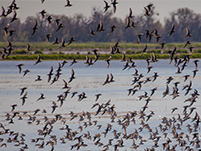Ecosystems: Increasing Resilience
By 2050, our planet will need to support roughly nine billion people. If we’re smart, we can supply enough food, water and shelter—and restore ecosystems.
How? By creating economic demand for farming, ranching, and water management programs that increase the resilience of natural systems.
Our ecosystems initiatives

Sustainable agriculture »
Why: Prevailing farming strategies are not efficient or adaptable enough to keep up with demand, especially with climate change underway.
How: We’re launching solutions that help retailers, food companies and farmers avoid the business risks of unsustainable agriculture practices.

Wildlife protection »
Why: Existing tools for protecting wildlife can no longer adequately preserve habitat facing encroachment, climate change and other threats.
How: We’re defending the Endangered Species Act and creating flexible solutions that balance wildlife protection and economic growth.

Coastal resilience »
Why: Climate change and sea level rise put coastal cities, from New Orleans to New York, at risk from rising seas and increased storms.
How: We’re working with engineers, policymakers and communities on restoration projects, like marsh creation, to protect nature and people.

Rebalance water use »
Why: Over-allocation of water in the West means rivers that serve as major watersheds are drying up, and groundwater reserves are dwindling.
How: We’re working with farmers, cities and policymakers to ensure water markets deliver benefits for wildlife and the economy.
Recent posts by our experts
Be part of our progress
With news updates and action alerts, you’ll find out when your support can help most. (See our privacy policy.)

